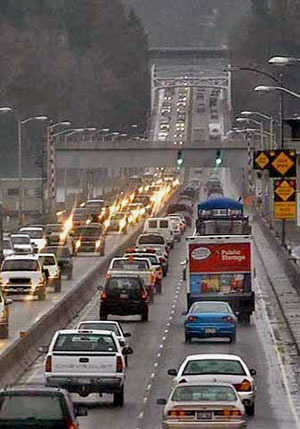transportation infrastructure. One such method is the implementation of high-
occupancy vehicle (HOV) lanes. HOV lanes are typically built on congested free-
ways, and allow vehicles that meet specified occupancy requirements to bypass
delays associated with driving alone on congested general-purpose lanes (GPLs)
of the freeway. HOV lanes encourage carpooling and increase person movement
along congested corridors (Turnbull 2004). HOV lanes promote the increase of
person movement through higher vehicle occupancies by providing travel time
savings to carpoolers (Turnbull 2004).
In the last 30 years, determined travelers have developed a new method of travel
that allows them to receive the benefits of traveling on the HOV lane without
forming traditional carpools (LeBlanc 1999). This new mode, known as casual car-
pooling or “slugging,” consists of impromptu carpools formed among strangers to
meet the occupancy requirements of HOV lanes.
The process of forming a casual carpool is relatively simple. Casual carpool pas-
sengers typically meet in a public area that has ample available parking, nearby
public transit as an alternate mode in case a casual carpool is unavailable, and close
proximity to the HOV facility. Drivers (also known as “body snatchers”) arrive and
pick up enough passengers to meet the HOV lane eligibility requirements. Driv-
ers then travel along the HOV lane and drop off passengers in a public location,
typically in the downtown area of a city. Details of the casual carpool process vary
slightly depending on location.
Currently, organized casual carpooling occurs in three U.S. metropolitan areas:
Washington, D.C. (LeBlanc 1999; Reno, Gellert, and Verzosa 1989; Spielberg and
Shapiro 2000), San Francisco (Beroldo 1990; RIDES for Bay Area Commuters, Inc.
1999), and Houston (Ojah and Burris 2004).
The slugging system in Washington, D.C., which has existed for more than 30 years,
is well organized with a large number of pick-up and drop-off locations and a
website (http://www.slug-lines.com) for local slugs and bodysnatchers. Conversely,
slugging in the San Francisco Bay area occurs in one general area. Passengers and
drivers meet in the morning peak period to form carpools and cross the Bay Bridge.
Passengers are usually dropped off in the downtown area and typically use transit
for their return trips. Casual carpooling in Houston occurs at three locations, all
of which feed the downtown area. Passengers meet at park-and-ride locations on
I-10 and US 290 that have direct access to HOV lanes. Drivers arrive throughout
the morning and pick up the necessary number of passengers to meet the HOV
occupancy requirement.









